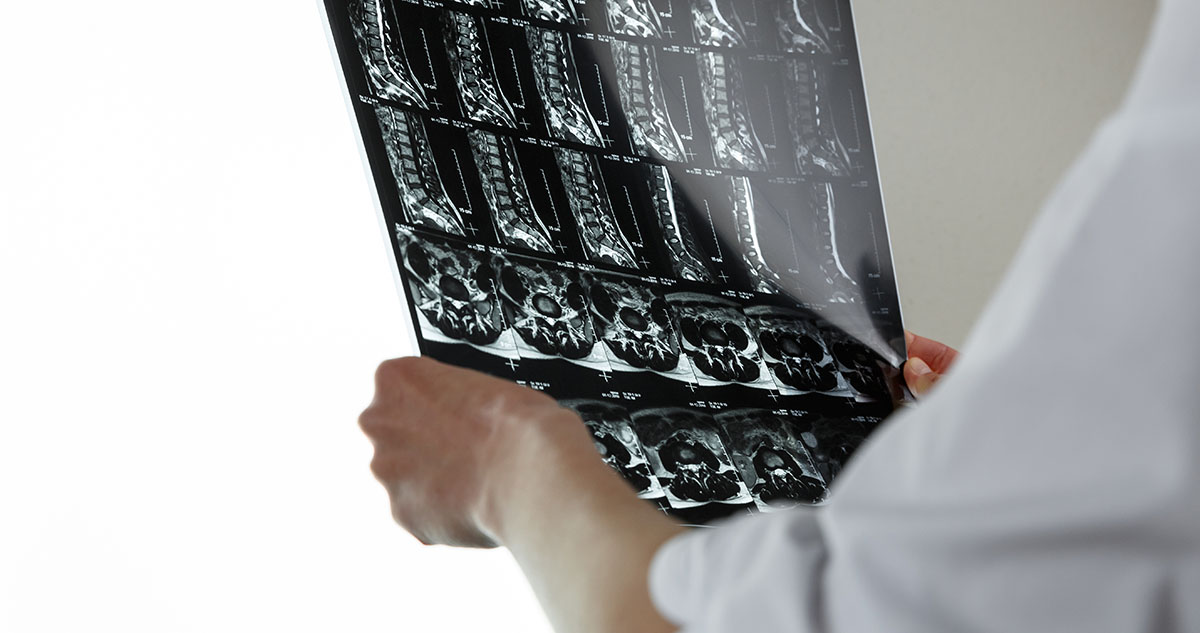The new CES pathway – does it enable clinicians to get treatment right first time?

The new treatment pathway for CES, delivered as part of the NHS’s Getting It Right First Time initiative to improve care for various conditions, is a positive step forward in ensuring better outcomes for people with cauda equina syndrome.
What is the CES pathway?
This new CES pathway creates a national framework for diagnosing and treating CES, which should help to iron out variations in the way the condition is created, improve outcomes for patients, and reduce litigation.
How has the new CES pathway been received?
After the pathway received widespread approval, we decided to seek the views of active clinicians as to how practice may be affected, and how the pathway may impact upon patient outcomes.
Looking for leading voices, we sought the views of Mr Francis Morris, a specialist consultant in emergency medicine with over 30 years of experience and who also acts as a medicolegal expert in CES cases, as well as Pip White, a practising musculoskeletal physiotherapist who works with a diverse range of patients with a variety of spinal problems.
We also obtained the thoughts of Claire Thornber, the founder of the Cauda Equina Champions Charity, a charity which supports thousands of people living with CES.
CES Pathway Analysis by Mr Francis Morris, Emergency Medicine Consultant
Cauda equina syndrome (CES) is a spinal surgical emergency that requires urgent assessment and intervention. Getting It Right First Time (GRFT) review of surgical spinal services in 2017-2019 identified “Significant and unwarranted variation in the detection of CES,” which led to the creation of the pathway.
A large lumbar disc prolapse is the most common cause of CES, but other causes such as haematoma, trauma, infection, tumour, etc. may also be responsible.
CES is a collection of clinical symptoms and signs which may be supported by MRI images but an MRI scan on its own cannot diagnose CES.
This statement underlines the fact that CES is a clinical diagnosis which is supported by MRI imaging.
CES is considered a surgical emergency as early intervention may prevent permanent loss of bladder, bowel and sexual function and paralysis of the lower limbs.
How does the CES pathway identify symptoms of CES?
The pathway identifies that CES should be suspected in any patient with back pain presenting with recent onset (within two weeks) of any of the following symptoms:
- Difficulty initiating micturition of impaired sensation of urinary flow.
- Altered perianal, perineal or genital sensation S2-S5 dermatomes – the area may be small or as big as a horse’s saddle (subjectively reported or objectively tested).
- Severe or progressive neurological deficit of both legs, such as major motor weakness with knee extension, ankle eversion or foot dorsiflexion.
- Loss of sensation of rectal fullness.
- Sexual dysfunction – inability to achieve an erection or to ejaculate, or loss of vaginal sensation.
This list of clinical symptoms is augmented by a comprehensive list of symptoms designed to be recognised by the patient when they are provided with safety net advice.
- Loss of feeling pins and needles between your inner thighs or genitals.
- Numbness in or around your back passage or buttocks.
- Altered feeling when using toilet paper to wipe yourself.
- Increasing difficulty when you try to urinate.
- Increase difficulty when you try to stop or control your flow of urine.
- Loss of sensation when you pass urine.
- Leaking urine or recent need to use pads.
- Not knowing when your bladder is either full or empty.
- Inability to stop a bowel movement or leaking.
- Loss of sensation when you pass a bowel motion.
- Change in ability to achieve an erection or ejaculate.
- Loss of sensation in genitals during sexual intercourse.
The pathway advises that patients should undergo a clinical assessment including a neurological assessment of the lower limbs but digital rectal examination is not necessary though the recording of any abnormal saddle sensation should be made.
This pathway is to be welcomed by all Emergency Department (ED) clinicians as it is a significant improvement on the two standard texts relied upon by the reasonably competent ED clinician which are the Oxford Handbook of Emergency Medicine (OHEM) and the NICE guidelines from 2016.
From an ED perspective, the approach to the patient with back pain should always focus on “Does this patient have any of the red flag symptoms or red flag signs of CES or not.” Those with red flag symptoms and/or signs should be referred urgently to the specialist team for an MRI scan. Those who have not can be discharged home with safety net advice.
The list of symptoms identified by the pathway both from the clinician and patient perspective are very helpful as they are much more extensive than those listed by NICE or the OHEM.
I find the comments on abnormal saddle sensation particularly helpful as it points out that anyone affected may have a large saddle-sized area or a very small area, and that symptoms may be subjective i.e. what the patient complains of, as opposed to the objective i.e. what is found on clinical examination.
One of the common errors in clinical assessment is to assume that the patient cannot have CES because of the clinician’s failure to be able to objectively validate their clear history of altered sensation in the saddle area.
The pathway helps to dispel the notion that subjective sensory loss in the saddle area is not a red flag symptom.
The clinical symptoms also cover sexual function, which in my experience is rarely enquired about by the reasonably competent ED clinician. The pathway helps this by providing a useful reminder of the symptoms associated with sexual dysfunction.
In terms of examination, the pathway endorses the need to perform a neurological examination of both legs, but no longer advocates a digital rectal examination. However, it does reinforce the fact that subjective or objective abnormal saddle sensation should be documented.
The comments about bladder scanning are helpful as this investigation is used much more frequently when assessing patients with suspected CES in the emergency department. Although, it is not yet standard and routine practice to do so.
It is clear that a post-void residual volume of <200 does not exclude CES. This is a very important statement that needs to be embraced by the ED community as it has been suggested that; normal post-void residual volume excludes CES and I am informed that this informs practice in some ED’s.
All emergency departments need to improve the advice they give to patients who are not suspected of having CES at the point of their discharge and the long list of symptoms to look out for. If provided as written advice, this could significantly improve patients’ safety.
Although it is currently accepted that providing safety net advice in such patients is mandatory at the point of discharge from the ED, it is often limited to incontinence of bladder or bowel function or loss of sensation in the saddle area.
How does the CES pathway address the challenges in diagnosis of cauda equina syndrome?
This much longer list of advice to patients will not only help to inform patients as to when to return but will also inform clinicians of the more subtle symptoms associated with CES.
The red flag of back pain and bilateral sciatica associated with a central disc prolapse which has only become common currency in ED practice since the publication of the 2016 NICE Guidelines is covered in the pathway and advocates that patients with such symptoms are at risk of CES and should be assessed by the specialist team within two weeks.
The algorithm displaying the pathway is in my opinion much less helpful than the focus on clinical symptoms and signs in the narrative, but it does serve to highlight one aspect of care which could be improved.
This is the situation where a patient has some red flag symptoms and/or signs and has a lumbar MRI scan which is negative. The algorithm suggests that in these patients’ alternative diagnoses should be considered.
In my experience, these patients frequently require whole spine imaging or assessment by a neurologist to help finesse the diagnosis. This is because there is no benign or self-limiting cause for developing a numb bum and this clinical symptom always requires an explanation even if the lumbar MRI scan reveals no compression of the cauda equina.
In conclusion, I believe the guideline will help refine the clinical diagnosis from an ED perspective as the clinical symptomatology as listed for clinicians and patients is much more extensive than standard texts used by the ED clinician.
The advice down-regulates the need to do a digital rectal examination which will be welcomed by patients and reminds the reasonably competent ED clinician that a normal bladder scan cannot exclude CES.
However in my opinion the most important aspect of the CES Pathway is the recognition that patients with an abnormal sensation in the saddle area should be taken as having CES until proven otherwise (even if their complaint of altered sensation cannot be confirmed objectively on clinical examination).
CES Pathway Analysis by Pip White, musculoskeletal physiotherapist
I am a musculoskeletal physiotherapist and see patients with a range of spinal problems. Most of the patients I see do not have a serious spinal pathology, but it is important to be able to identify patients with serious pathology and get them seen by appropriate specialists quickly.
Standardised pathways facilitate quality improvement work within individual services to seek to reduce unwarranted variation in care provision within with NHS as a whole. This ultimately is better for patients who can be assured of more consistent service expectations regardless of where they live in England.
I very much welcome the new pathway and realise how important it is that all physiotherapists working within MSK pathways have access to high quality evidence based clinical information to support our clinical decisions and management of patients. For the first time, there is an agreed standardised management pathway in England, that has been collaboratively developed by a number of healthcare professional organisations and lived experience patient groups, which can now act as a fixed point for what high-quality care looks like.
How does the CES pathway triage patients for emergency & urgent medical attention?
A key new point within the pathway is the introduction of a two-week timepoint as being the delineator between emergency and urgent presentations of CES, which give much needed clarity. The pathway is interactive, so can be used in real time to support either direct patient management or continuing professional development. It is also illustrated as a visual flow chart which makes it much more accessible to understand the pathway from start to finish (or pin up in your clinic room as a quick prompt!)
I have considered the triage requirement that the patient must have CES symptoms arising within the last two weeks, in order to get an emergency referral, in the context of the possibility that sometimes CES symptoms can last for longer than two weeks, and this might exclude someone who needed urgent referral because they had a “slow onset” of symptoms. Defining the terms ‘emergency’ and ‘urgent’ in absolute terms is difficult as clinical care always requires personalisation to the unique presentation of the individual patient in front of you in clinic. However, for the first time, this pathway has used a two-week marker as a differentiation between ‘emergency’ and ‘urgent’ presentations. Those with slower onset symptoms that have been evident for more than two weeks will continue to be referred as ‘urgent’, but the pathway now makes it clear that symptoms that have lasted longer than two weeks are not a time-critical emergency presentation. The two-week time point will likely provoke continued debate, but for the time being it provides clarity based on the evidence available to us right now, until any future clinical evidence indicates it should be changed.
How does this address the issues from an MSK point of view?
This GIRFT pathway for England (other pathways either exist and/or are being planned for Scotland, Wales and Northern Ireland) is a great example of collaborative working to provide a standardised pathway for CES management, which is a complex condition that has no set presentation. Having a national pathway is the right thing to do as it can reduce unwarranted variation in care and act as a quality improvement tool for services. The importance of the need for ‘safety-netting’ cannot be underestimated and the links to the CES advice cards are important and are an easy resource to provide to patients. It’s important to recognise this pathway is a living document that has been created nationally and it now requires all services to implement it into local service provision. Challenges will likely still remain, particularly around variable local pressures in ED departments and 24/7 access to MRI scans, but this pathway is a good step forward, and no doubt will be refined and further developed as further data and evidence inform future versions.
Other questions related to the CES pathway
We also asked our experts some particular questions around potential areas of contention in the pathway, to clarify how it has progressed understanding of cauda equina syndrome treatment:
What does the CES pathway say about bladder screening?
“In terms of bladder scanning the document points out that 60% of patients who underwent emergency decompressive surgery for CES had a post-residual volume of urine in their bladder of < 200 ml.
For patients with > 600 ml in their bladder, and are unable to void, will require the use of a catheter.”
Francis Morris
“I have considered the issue of bladder scanning, which is referred to in the protocol in the context of emergency MRI scanning. The pathway is illustrated in a flow-diagram format but the webinar that supported the pathway launch was clear that an MRI scan ought not to be delayed whilst waiting for a bladder scan, and that in reality both tests may be requested simultaneously and could occur in any order provided that the MRI is not delayed. It’s important to remember that CES, as with most conditions, is not diagnosed on the basis of the results of any individual technical investigation in isolation, but after proper clinical consideration of the patient, the examination and any investigations, taken as a whole.”
Pip White
What does the CES pathway advise on MRI scanning?
“MRI scanning is the investigation of choice and should be undertaken as soon as possible, “and certainly within 4 hours of request to radiology.”
Patients should be referred to the spinal team. The pathway makes it implicit that the MRI scan would be performed before transfer to the spinal surgical services.
The pathway is comprehensive and provides details on how to provide 24-hour MRI scanning, suggests an MRI protocol and how to conduct reporting of MRI scanning.
In addition, it provides advice on the timing of surgical intervention, post-operative care, pain relief and postoperative assessment of urinary, bowel and sexual function along with psychological support.”
Francis Morris
Are there any dangers of cauda equina syndrome going undiagnosed via the MSK route?
“In my view, the “community MSK interface” referred to in the pathway as the alternative referral pathway has the requisite knowledge and experience of CES to triage and refer effectively. MSK interface services have been an established part of musculoskeletal pathways for many years now and are the established route by which those working in primary and community care are able to access specialist orthopaedic opinion for a range of MSK conditions. The staff who work in MSK interface services include highly trained and skilled physiotherapists who do have the required knowledge, skills and capabilities at an advanced level to manage a range of MSK conditions, including those conditions, such as CES that may, or may not, be a time-critical emergency. These staff also have the ability to triage and refer on appropriately.
I have considered whether there is a danger of CES going undiagnosed if the pathway results in more patients going down the “community MSK interface” route than the emergency route in the first instance. CES is diagnosed predominantly on the subjective history and the pathway now distinguishes which route should be followed depending on the nature of signs and symptoms elicited from the patient within the MSK interface clinic. This pathway enables all patients diagnosed with CES to be managed, and the pathway now provides clear distinction as to which patients with suspected CES need time critical emergency attention, and those that require urgent attention.”
Pip White
Comments from Claire Thornber, Founder of the Cauda Equina Champions Charity
Claire Thornber has been campaigning for an effective and consistent pathway for the diagnosis and treatment of CES for many years. Not surprisingly she welcomes the pathway and hopes and expects it to reduce harm to patients, and enable them to receive the treatment and care they need.
Just as importantly, Claire hopes that he pathway will lead to better rehabilitation pathways for CES patients, who are all too often dismissed without the correct support, and forgotten in the system.
Claire, however, expresses concern about one aspect of the pathway in particular, stating:
“I do have reservations about the recent onset (within 2 weeks) part of the criteria and there was much debate around this issue in the pathway working group. We surveyed our members about the onset of bladder symptoms with the majority reporting that with the benefit of hindsight they reported onset of bladder symptoms within the previous two months. I believe that this part of the pathway will need to be looked at again to widen the criteria and personally would have been happier with a recommendation of within 4 weeks.
Since the announcement of the pathway, we have dealt with enquiries from incomplete CES patients over the phone who after a CES diagnosis via MRI scan are sent home to be recalled at a later date, for elective surgery. The ever-increasing problems of resources, access to scanning and staffing within the NHS mean that for every confirmed case of incomplete CES there is perhaps a greater gamble than ever, risking outcomes for that patient should they go on to develop full blown CES if they have been discharged to wait for surgery.
For every incomplete CES patient that is discharged home there is a high risk of then developing full blown CES. This can occur at any time and sometimes just turning in bed, or a sneeze will be the catalyst that sets the 24-hour clock ticking.”
How does the new CES pathway reduce the risk of negligence?
One of the most important considerations from a legal point of view is the status which the pathway may have in terms of representing best practice, and whether deviating from it will be regarded as representing sub-standard care of cauda equina syndrome. Guidelines are rarely regarded as definitive in determining whether there has been breach of duty, but such a carefully researched piece of work as this, deriving from many contributors, is likely to carry great weight in the courts.
A second consideration is the treatment of bilateral sciatica. Bilateral sciatica was added to the NICE guidance as a “red flag” symptom” of CES in amended guidance in 2018, and that guidance suggested emergency referral was mandated if such red flag symptoms suggested CES or another serious underlying cause, but only urgent referral (within two weeks) if red flags exist in the absence of neurological dysfunction. The new pathway is not inconsistent with the NICE guidance, but is clear in stating that sudden onset bilateral radicular pain (bilateral sciatica) should lead to urgent referral within two weeks rather than emergency referral.
The guidance is slightly at odds with GP Notebook, a guide to best practice used by many GPs, which does appear to mandate emergency referral for bilateral sciatica. It is not entirely clear where the pathway now leaves us on bilateral sciatica, but it feels as though its importance as a standalone symptom has been somewhat downgraded.
Is a ‘subjective’ complaint of saddle numbness enough?
The fact that the pathway does not mandate digital rectal examination is important, in the context of the point made by Mr Morris about subjective loss or change of sensation in the saddle area.
Legal practitioners specialising in CES will be very familiar with arguments about signs versus symptoms, and the objective lack of signs such as loss of anal tone trumping subjective complaints of numbness. It seems that now subjective numbness ought to be treated as a genuine red flag sign, without corroborating evidence from examination, which may prove to be very important in the context of litigation.
On a similar note, Mr Morris makes the important point that the size of the area of numbness, or change of sensation, should not be a factor in rating its significance as a symptom, and that this too may play a role in determining the outcome of litigation.
Bladder screening – a welcome clarification
Mr Morris also makes a highly relevant point about the status of bladder scanning.
Patients with suspected CES are often given ultrasound scans of the bladder before and after passing urine, with diagnostic significance being placed upon the level of urine remaining post-voiding.
The pathway makes it clear that a post-void residual volume of less than 200 ml does not exclude CES, and Mr Morris notes that this is a very important statement, given that some emergency departments have used such an outcome as a way of excluding a CES diagnosis. That should no longer be regarded as good practice, which may again be an important factor in litigation.
An update to red flag guidance
The very comprehensive list of red flag symptoms listed by the pathway is also to be welcomed, since it is more comprehensive than the list contained in the NICE Guidance or in the Oxford Handbook of Emergency Medicine.
The list of red flag symptoms in the pathway will be used as the benchmark for the quality of safety-netting advice given to patients with sciatica, going forward, and will become an important document to consider in “failure to warn” cases.
Two-week triage – is it the right cut-off point?
Claire Thornber has expressed concern above that defining the need for emergency treatment by recent onset of symptoms (within two weeks) is dangerous. A survey of the charity’s membership suggests that the onset of bladder symptoms is often significantly more gradual, more often extending over two months. Claire is concerned that this particular criterion may lead to patients needing emergency treatment being wrongly triaged into the less urgent pathway.
On the other hand, Pip White seems confident that the musculo-skeletal practitioners charged with caring for the ”less urgent” group are highly qualified to do so, and can triage and refer back into the emergency pathway as required. Claire’s preference for a four-week criterion may find favour as the pathway evolves in the future.
Four hours to MRI – possible at present?
The pathway recommends that an MRI scan should be performed as soon as possible, “and certainly within four hours of request to radiology”. This is a recommendation which is probably out of kilter with the realities on the ground, in the present context of the availability of MRI scanning facilities.
Undoubtedly in cases which I see in my practice, the delay in performing an MRI scan may be much longer than four hours, and sometimes longer than 12 hours. The pathway also proposes that local provision for a 24-hour MRI scanning facility should be in place by June 2024. Further, the pathway states: “Where this is not possible currently, a standard operating procedure in conjunction with local spinal and radiology services should be in place describing the local pathway for urgent out of hours scanning”. Again, in terms of litigation, such a standard operating procedure will be a very important document in helping to determine liability.
Finally, the pathway provides important guidance for the catheterisation of patients prior to surgery, noting that patients with more than 600 ml in their bladder who are unable to void require catheterisation, and the need for TWOC (trial without catheterisation) post-operatively. This has importance in the context of litigation as urine retention can in and of itself cause permanent bladder injury, and such cases are not uncommon.
There is a unanimous view that the new CES pathway is a positive development, and that it will improve practice, speed up diagnosis, and create much-needed consistency on a national basis. Equally importantly, the pathway will open the door to effective rehabilitation for patients with CES, and enable referral to groups like the Cauda Equina Champions Charity, who can offer much-needed help, in terms of psychological support and support for the many patients whose sexual function has been affected, for example.
There remains much to do, though. The protocol will need to be refined and improved, as time goes on. Lack of resource, especially in relation to MRI scanning facilities, remains a huge problem, which the pathway cannot solve. There is no doubt, however, that the pathway is a significant step forward towards national consistency of practice, and should lead to better outcomes for patients, while also offering a standard against which good and poor practice can be effectively measured.
The last word should be left with Claire Thornber:
“I started my work around CES pathway in 2012 and have spent many years campaigning for the lack of a national pathway to be addressed.
If I sit and think about the improved outcomes that could have been achieved for literally thousands of CES patients over this time period, it makes me emotional. The personal cost to patients is devastating and life changing and much of it avoidable.
We must embrace the new pathway and continue to fight for improvements, whilst at the same time support the dedicated healthcare professionals who are working so hard to improve outcomes and services for patients. I am proud to be able to tell our charity members that the NHS is addressing this issue and finally they are being heard.”
If you have suffered an injury as a result of delayed or otherwise negligent care of cauda equina syndrome, our specialist solicitors may be able to help you seek compensation.
Call now








